Strategic Analysis and Recommendations for Wesfarmers
VerifiedAdded on 2020/05/04
|20
|3912
|162
AI Summary
The assignment requires an in-depth analysis of Wesfarmers' corporate strategy, focusing on evaluating their current performance and market position. Students will conduct a SWOT analysis to uncover internal strengths and weaknesses as well as external opportunities and threats. This task involves examining the company's organizational structure, strategic objectives, competitive landscape, and financial health. Based on these insights, students are expected to develop strategic recommendations aimed at enhancing Wesfarmers' overall performance and achieving long-term business goals. The assignment will culminate in a comprehensive report that synthesizes research findings and presents well-founded strategies for future growth and success.
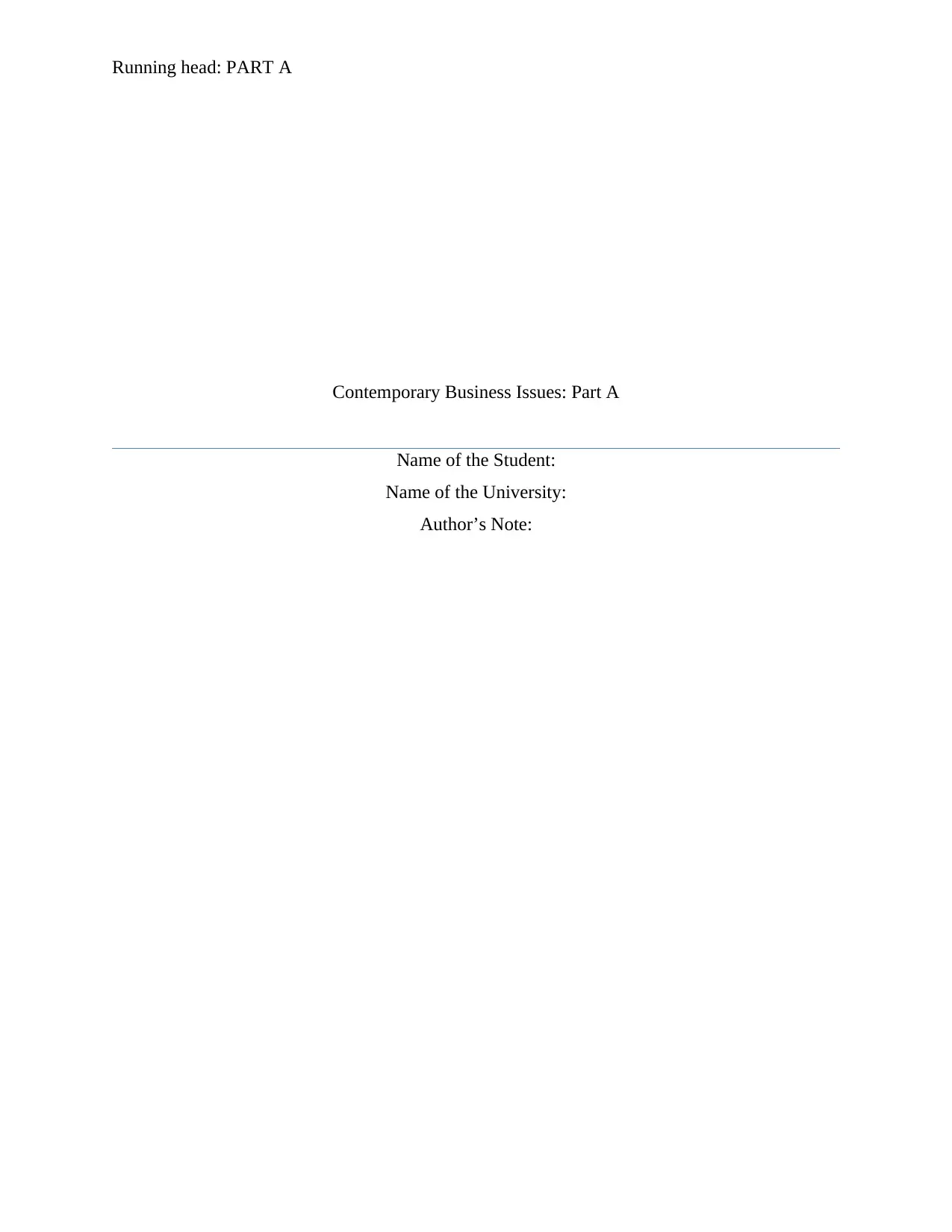
Running head: PART A
Contemporary Business Issues: Part A
Name of the Student:
Name of the University:
Author’s Note:
Contemporary Business Issues: Part A
Name of the Student:
Name of the University:
Author’s Note:
Paraphrase This Document
Need a fresh take? Get an instant paraphrase of this document with our AI Paraphraser
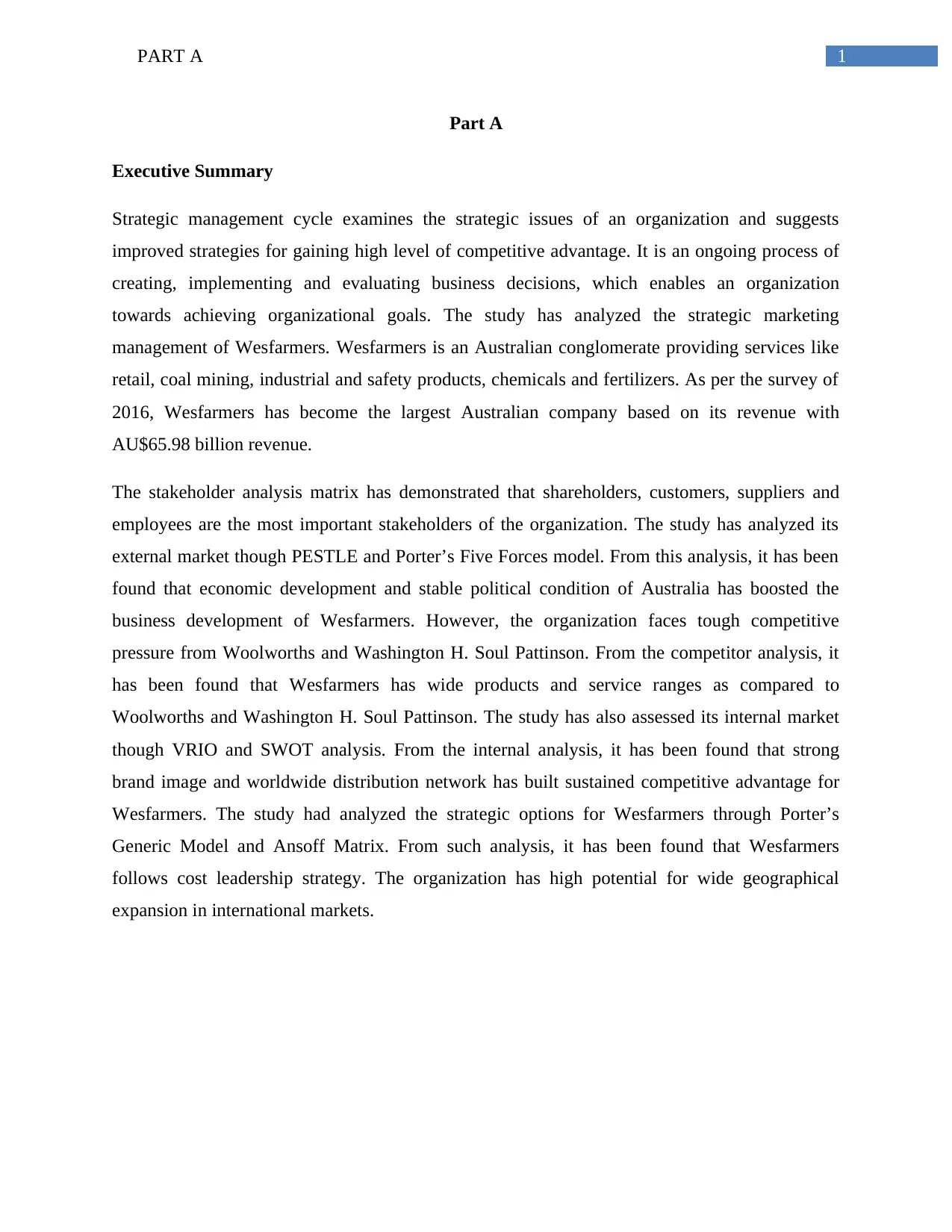
1PART A
Part A
Executive Summary
Strategic management cycle examines the strategic issues of an organization and suggests
improved strategies for gaining high level of competitive advantage. It is an ongoing process of
creating, implementing and evaluating business decisions, which enables an organization
towards achieving organizational goals. The study has analyzed the strategic marketing
management of Wesfarmers. Wesfarmers is an Australian conglomerate providing services like
retail, coal mining, industrial and safety products, chemicals and fertilizers. As per the survey of
2016, Wesfarmers has become the largest Australian company based on its revenue with
AU$65.98 billion revenue.
The stakeholder analysis matrix has demonstrated that shareholders, customers, suppliers and
employees are the most important stakeholders of the organization. The study has analyzed its
external market though PESTLE and Porter’s Five Forces model. From this analysis, it has been
found that economic development and stable political condition of Australia has boosted the
business development of Wesfarmers. However, the organization faces tough competitive
pressure from Woolworths and Washington H. Soul Pattinson. From the competitor analysis, it
has been found that Wesfarmers has wide products and service ranges as compared to
Woolworths and Washington H. Soul Pattinson. The study has also assessed its internal market
though VRIO and SWOT analysis. From the internal analysis, it has been found that strong
brand image and worldwide distribution network has built sustained competitive advantage for
Wesfarmers. The study had analyzed the strategic options for Wesfarmers through Porter’s
Generic Model and Ansoff Matrix. From such analysis, it has been found that Wesfarmers
follows cost leadership strategy. The organization has high potential for wide geographical
expansion in international markets.
Part A
Executive Summary
Strategic management cycle examines the strategic issues of an organization and suggests
improved strategies for gaining high level of competitive advantage. It is an ongoing process of
creating, implementing and evaluating business decisions, which enables an organization
towards achieving organizational goals. The study has analyzed the strategic marketing
management of Wesfarmers. Wesfarmers is an Australian conglomerate providing services like
retail, coal mining, industrial and safety products, chemicals and fertilizers. As per the survey of
2016, Wesfarmers has become the largest Australian company based on its revenue with
AU$65.98 billion revenue.
The stakeholder analysis matrix has demonstrated that shareholders, customers, suppliers and
employees are the most important stakeholders of the organization. The study has analyzed its
external market though PESTLE and Porter’s Five Forces model. From this analysis, it has been
found that economic development and stable political condition of Australia has boosted the
business development of Wesfarmers. However, the organization faces tough competitive
pressure from Woolworths and Washington H. Soul Pattinson. From the competitor analysis, it
has been found that Wesfarmers has wide products and service ranges as compared to
Woolworths and Washington H. Soul Pattinson. The study has also assessed its internal market
though VRIO and SWOT analysis. From the internal analysis, it has been found that strong
brand image and worldwide distribution network has built sustained competitive advantage for
Wesfarmers. The study had analyzed the strategic options for Wesfarmers through Porter’s
Generic Model and Ansoff Matrix. From such analysis, it has been found that Wesfarmers
follows cost leadership strategy. The organization has high potential for wide geographical
expansion in international markets.
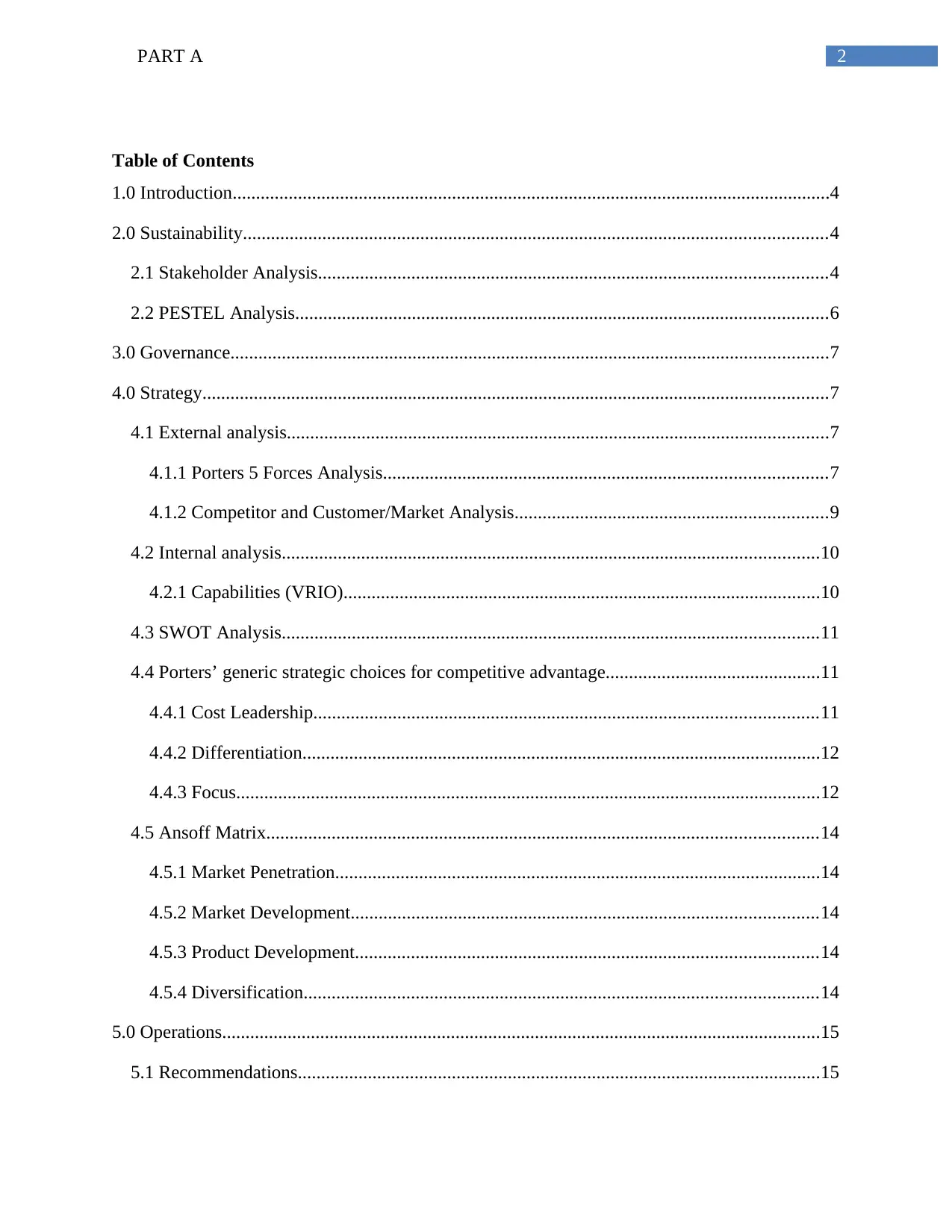
2PART A
Table of Contents
1.0 Introduction................................................................................................................................4
2.0 Sustainability.............................................................................................................................4
2.1 Stakeholder Analysis.............................................................................................................4
2.2 PESTEL Analysis..................................................................................................................6
3.0 Governance................................................................................................................................7
4.0 Strategy......................................................................................................................................7
4.1 External analysis....................................................................................................................7
4.1.1 Porters 5 Forces Analysis...............................................................................................7
4.1.2 Competitor and Customer/Market Analysis...................................................................9
4.2 Internal analysis...................................................................................................................10
4.2.1 Capabilities (VRIO)......................................................................................................10
4.3 SWOT Analysis...................................................................................................................11
4.4 Porters’ generic strategic choices for competitive advantage..............................................11
4.4.1 Cost Leadership............................................................................................................11
4.4.2 Differentiation...............................................................................................................12
4.4.3 Focus.............................................................................................................................12
4.5 Ansoff Matrix......................................................................................................................14
4.5.1 Market Penetration........................................................................................................14
4.5.2 Market Development....................................................................................................14
4.5.3 Product Development...................................................................................................14
4.5.4 Diversification..............................................................................................................14
5.0 Operations................................................................................................................................15
5.1 Recommendations................................................................................................................15
Table of Contents
1.0 Introduction................................................................................................................................4
2.0 Sustainability.............................................................................................................................4
2.1 Stakeholder Analysis.............................................................................................................4
2.2 PESTEL Analysis..................................................................................................................6
3.0 Governance................................................................................................................................7
4.0 Strategy......................................................................................................................................7
4.1 External analysis....................................................................................................................7
4.1.1 Porters 5 Forces Analysis...............................................................................................7
4.1.2 Competitor and Customer/Market Analysis...................................................................9
4.2 Internal analysis...................................................................................................................10
4.2.1 Capabilities (VRIO)......................................................................................................10
4.3 SWOT Analysis...................................................................................................................11
4.4 Porters’ generic strategic choices for competitive advantage..............................................11
4.4.1 Cost Leadership............................................................................................................11
4.4.2 Differentiation...............................................................................................................12
4.4.3 Focus.............................................................................................................................12
4.5 Ansoff Matrix......................................................................................................................14
4.5.1 Market Penetration........................................................................................................14
4.5.2 Market Development....................................................................................................14
4.5.3 Product Development...................................................................................................14
4.5.4 Diversification..............................................................................................................14
5.0 Operations................................................................................................................................15
5.1 Recommendations................................................................................................................15
⊘ This is a preview!⊘
Do you want full access?
Subscribe today to unlock all pages.

Trusted by 1+ million students worldwide
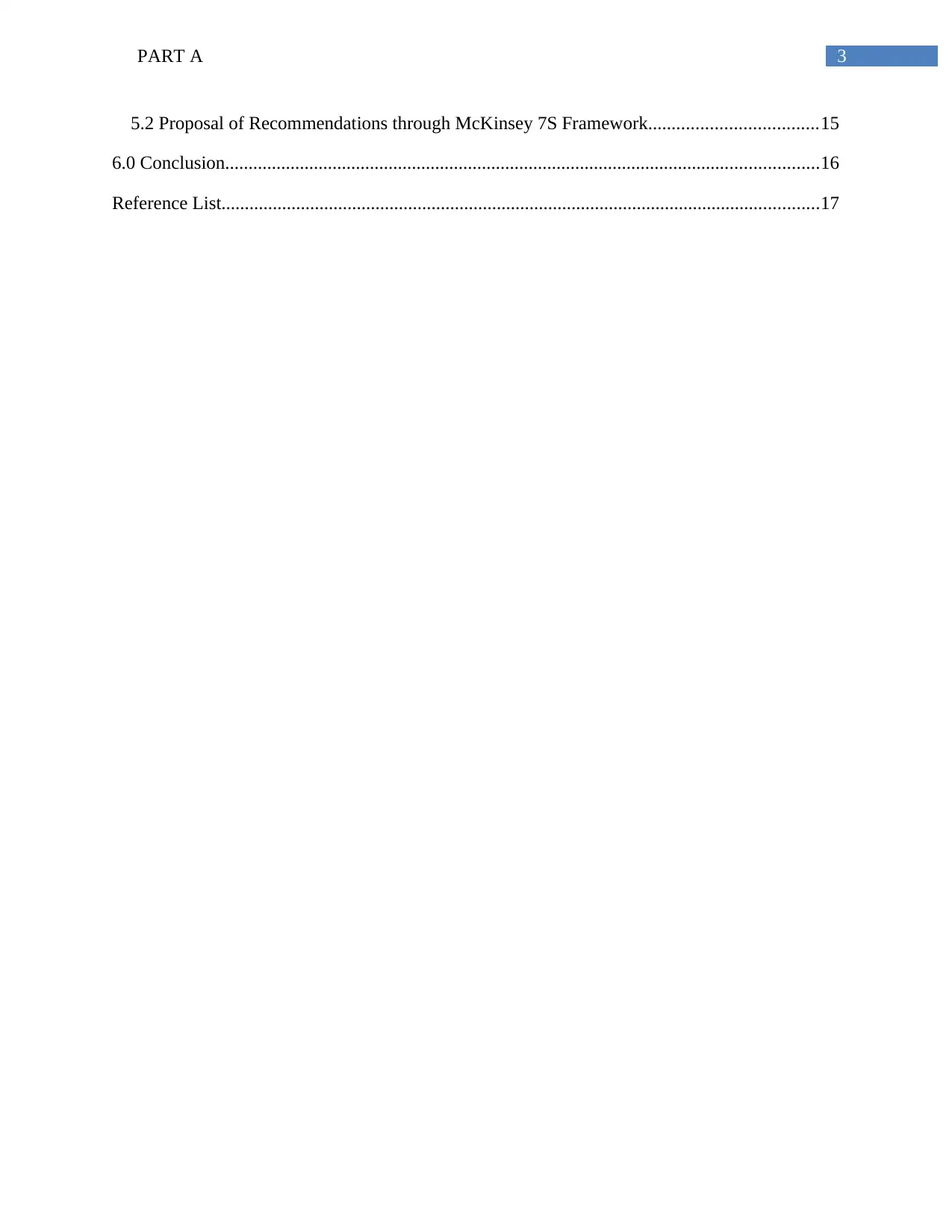
3PART A
5.2 Proposal of Recommendations through McKinsey 7S Framework....................................15
6.0 Conclusion...............................................................................................................................16
Reference List................................................................................................................................17
5.2 Proposal of Recommendations through McKinsey 7S Framework....................................15
6.0 Conclusion...............................................................................................................................16
Reference List................................................................................................................................17
Paraphrase This Document
Need a fresh take? Get an instant paraphrase of this document with our AI Paraphraser
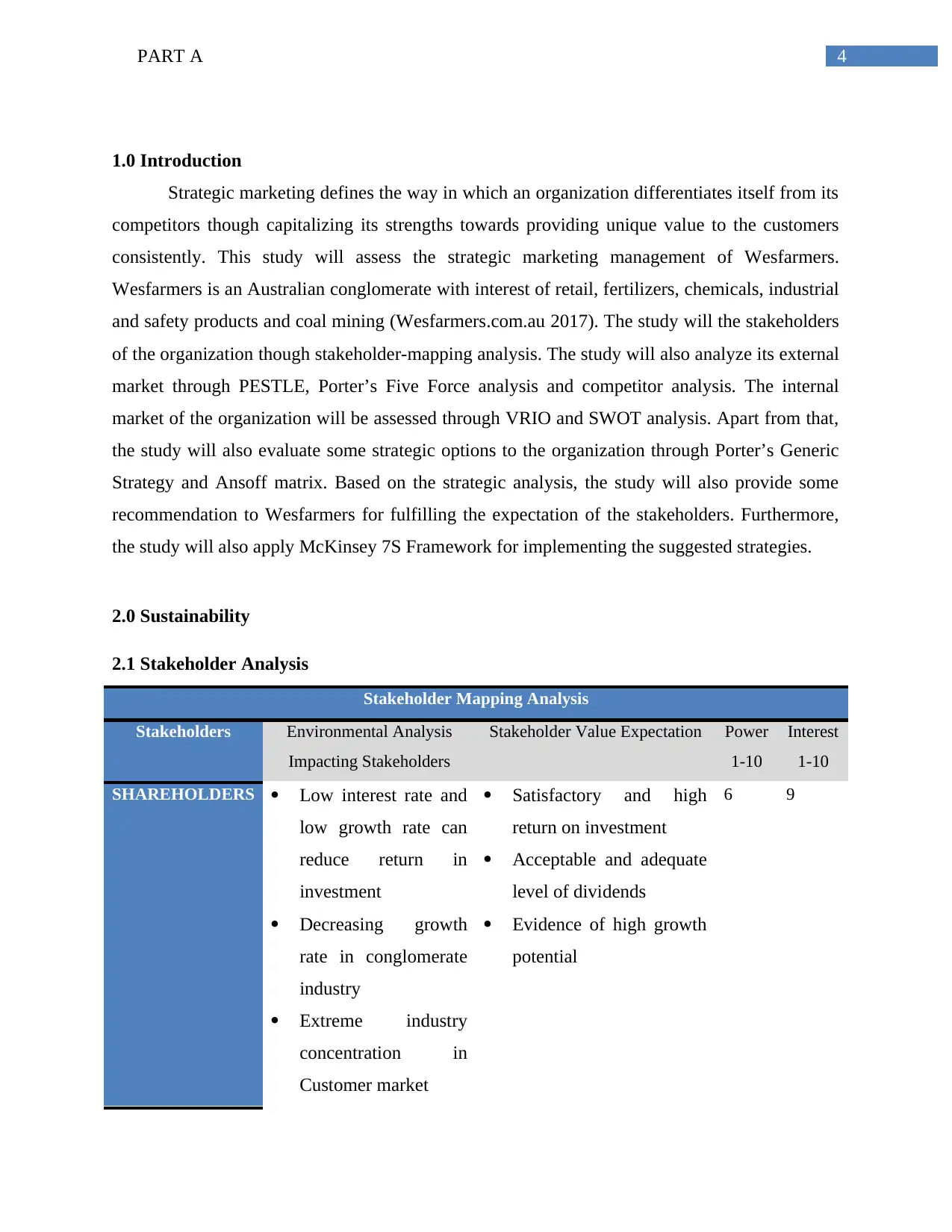
4PART A
1.0 Introduction
Strategic marketing defines the way in which an organization differentiates itself from its
competitors though capitalizing its strengths towards providing unique value to the customers
consistently. This study will assess the strategic marketing management of Wesfarmers.
Wesfarmers is an Australian conglomerate with interest of retail, fertilizers, chemicals, industrial
and safety products and coal mining (Wesfarmers.com.au 2017). The study will the stakeholders
of the organization though stakeholder-mapping analysis. The study will also analyze its external
market through PESTLE, Porter’s Five Force analysis and competitor analysis. The internal
market of the organization will be assessed through VRIO and SWOT analysis. Apart from that,
the study will also evaluate some strategic options to the organization through Porter’s Generic
Strategy and Ansoff matrix. Based on the strategic analysis, the study will also provide some
recommendation to Wesfarmers for fulfilling the expectation of the stakeholders. Furthermore,
the study will also apply McKinsey 7S Framework for implementing the suggested strategies.
2.0 Sustainability
2.1 Stakeholder Analysis
Stakeholder Mapping Analysis
Stakeholders Environmental Analysis
Impacting Stakeholders
Stakeholder Value Expectation Power
1-10
Interest
1-10
SHAREHOLDERS Low interest rate and
low growth rate can
reduce return in
investment
Decreasing growth
rate in conglomerate
industry
Extreme industry
concentration in
Customer market
Satisfactory and high
return on investment
Acceptable and adequate
level of dividends
Evidence of high growth
potential
6 9
1.0 Introduction
Strategic marketing defines the way in which an organization differentiates itself from its
competitors though capitalizing its strengths towards providing unique value to the customers
consistently. This study will assess the strategic marketing management of Wesfarmers.
Wesfarmers is an Australian conglomerate with interest of retail, fertilizers, chemicals, industrial
and safety products and coal mining (Wesfarmers.com.au 2017). The study will the stakeholders
of the organization though stakeholder-mapping analysis. The study will also analyze its external
market through PESTLE, Porter’s Five Force analysis and competitor analysis. The internal
market of the organization will be assessed through VRIO and SWOT analysis. Apart from that,
the study will also evaluate some strategic options to the organization through Porter’s Generic
Strategy and Ansoff matrix. Based on the strategic analysis, the study will also provide some
recommendation to Wesfarmers for fulfilling the expectation of the stakeholders. Furthermore,
the study will also apply McKinsey 7S Framework for implementing the suggested strategies.
2.0 Sustainability
2.1 Stakeholder Analysis
Stakeholder Mapping Analysis
Stakeholders Environmental Analysis
Impacting Stakeholders
Stakeholder Value Expectation Power
1-10
Interest
1-10
SHAREHOLDERS Low interest rate and
low growth rate can
reduce return in
investment
Decreasing growth
rate in conglomerate
industry
Extreme industry
concentration in
Customer market
Satisfactory and high
return on investment
Acceptable and adequate
level of dividends
Evidence of high growth
potential
6 9
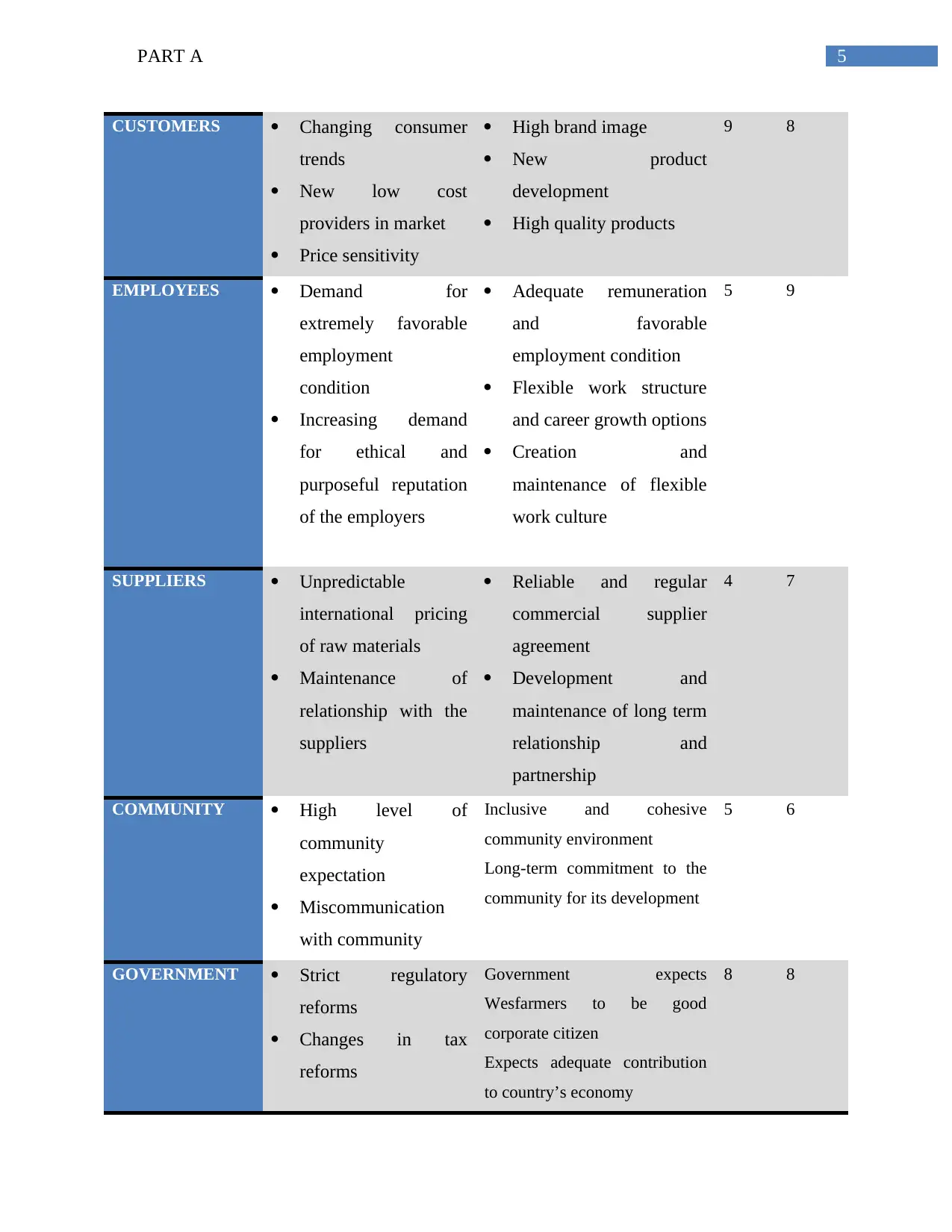
5PART A
CUSTOMERS Changing consumer
trends
New low cost
providers in market
Price sensitivity
High brand image
New product
development
High quality products
9 8
EMPLOYEES Demand for
extremely favorable
employment
condition
Increasing demand
for ethical and
purposeful reputation
of the employers
Adequate remuneration
and favorable
employment condition
Flexible work structure
and career growth options
Creation and
maintenance of flexible
work culture
5 9
SUPPLIERS Unpredictable
international pricing
of raw materials
Maintenance of
relationship with the
suppliers
Reliable and regular
commercial supplier
agreement
Development and
maintenance of long term
relationship and
partnership
4 7
COMMUNITY High level of
community
expectation
Miscommunication
with community
Inclusive and cohesive
community environment
Long-term commitment to the
community for its development
5 6
GOVERNMENT Strict regulatory
reforms
Changes in tax
reforms
Government expects
Wesfarmers to be good
corporate citizen
Expects adequate contribution
to country’s economy
8 8
CUSTOMERS Changing consumer
trends
New low cost
providers in market
Price sensitivity
High brand image
New product
development
High quality products
9 8
EMPLOYEES Demand for
extremely favorable
employment
condition
Increasing demand
for ethical and
purposeful reputation
of the employers
Adequate remuneration
and favorable
employment condition
Flexible work structure
and career growth options
Creation and
maintenance of flexible
work culture
5 9
SUPPLIERS Unpredictable
international pricing
of raw materials
Maintenance of
relationship with the
suppliers
Reliable and regular
commercial supplier
agreement
Development and
maintenance of long term
relationship and
partnership
4 7
COMMUNITY High level of
community
expectation
Miscommunication
with community
Inclusive and cohesive
community environment
Long-term commitment to the
community for its development
5 6
GOVERNMENT Strict regulatory
reforms
Changes in tax
reforms
Government expects
Wesfarmers to be good
corporate citizen
Expects adequate contribution
to country’s economy
8 8
⊘ This is a preview!⊘
Do you want full access?
Subscribe today to unlock all pages.

Trusted by 1+ million students worldwide
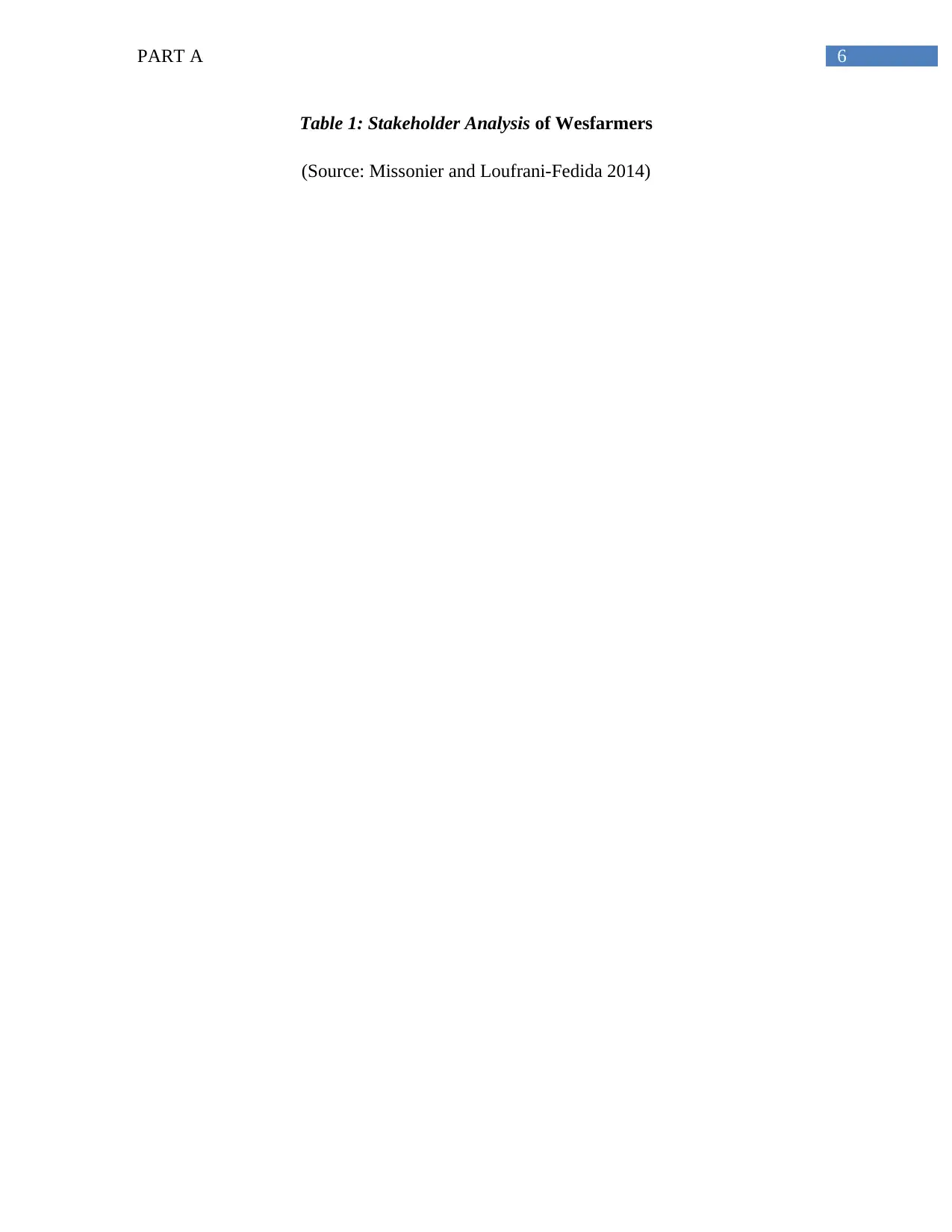
6PART A
Table 1: Stakeholder Analysis of Wesfarmers
(Source: Missonier and Loufrani-Fedida 2014)
Table 1: Stakeholder Analysis of Wesfarmers
(Source: Missonier and Loufrani-Fedida 2014)
Paraphrase This Document
Need a fresh take? Get an instant paraphrase of this document with our AI Paraphraser
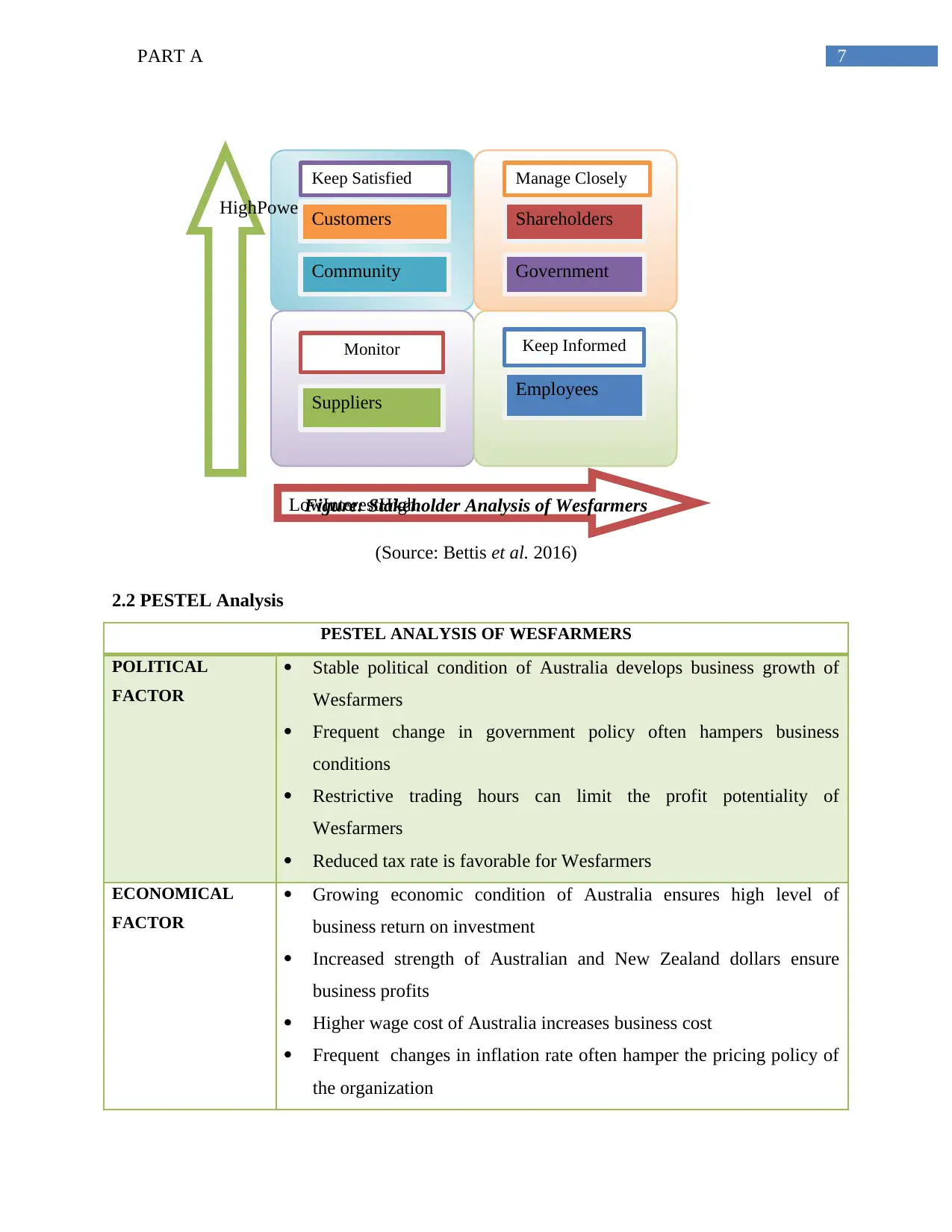
7PART A
LowInterestHigh
HighPowerLow Shareholders
Government
Customers
Community
Suppliers Employees
Keep Satisfied Manage Closely
Monitor Keep Informed
Figure: Stakeholder Analysis of Wesfarmers
(Source: Bettis et al. 2016)
2.2 PESTEL Analysis
PESTEL ANALYSIS OF WESFARMERS
POLITICAL
FACTOR
Stable political condition of Australia develops business growth of
Wesfarmers
Frequent change in government policy often hampers business
conditions
Restrictive trading hours can limit the profit potentiality of
Wesfarmers
Reduced tax rate is favorable for Wesfarmers
ECONOMICAL
FACTOR
Growing economic condition of Australia ensures high level of
business return on investment
Increased strength of Australian and New Zealand dollars ensure
business profits
Higher wage cost of Australia increases business cost
Frequent changes in inflation rate often hamper the pricing policy of
the organization
LowInterestHigh
HighPowerLow Shareholders
Government
Customers
Community
Suppliers Employees
Keep Satisfied Manage Closely
Monitor Keep Informed
Figure: Stakeholder Analysis of Wesfarmers
(Source: Bettis et al. 2016)
2.2 PESTEL Analysis
PESTEL ANALYSIS OF WESFARMERS
POLITICAL
FACTOR
Stable political condition of Australia develops business growth of
Wesfarmers
Frequent change in government policy often hampers business
conditions
Restrictive trading hours can limit the profit potentiality of
Wesfarmers
Reduced tax rate is favorable for Wesfarmers
ECONOMICAL
FACTOR
Growing economic condition of Australia ensures high level of
business return on investment
Increased strength of Australian and New Zealand dollars ensure
business profits
Higher wage cost of Australia increases business cost
Frequent changes in inflation rate often hamper the pricing policy of
the organization
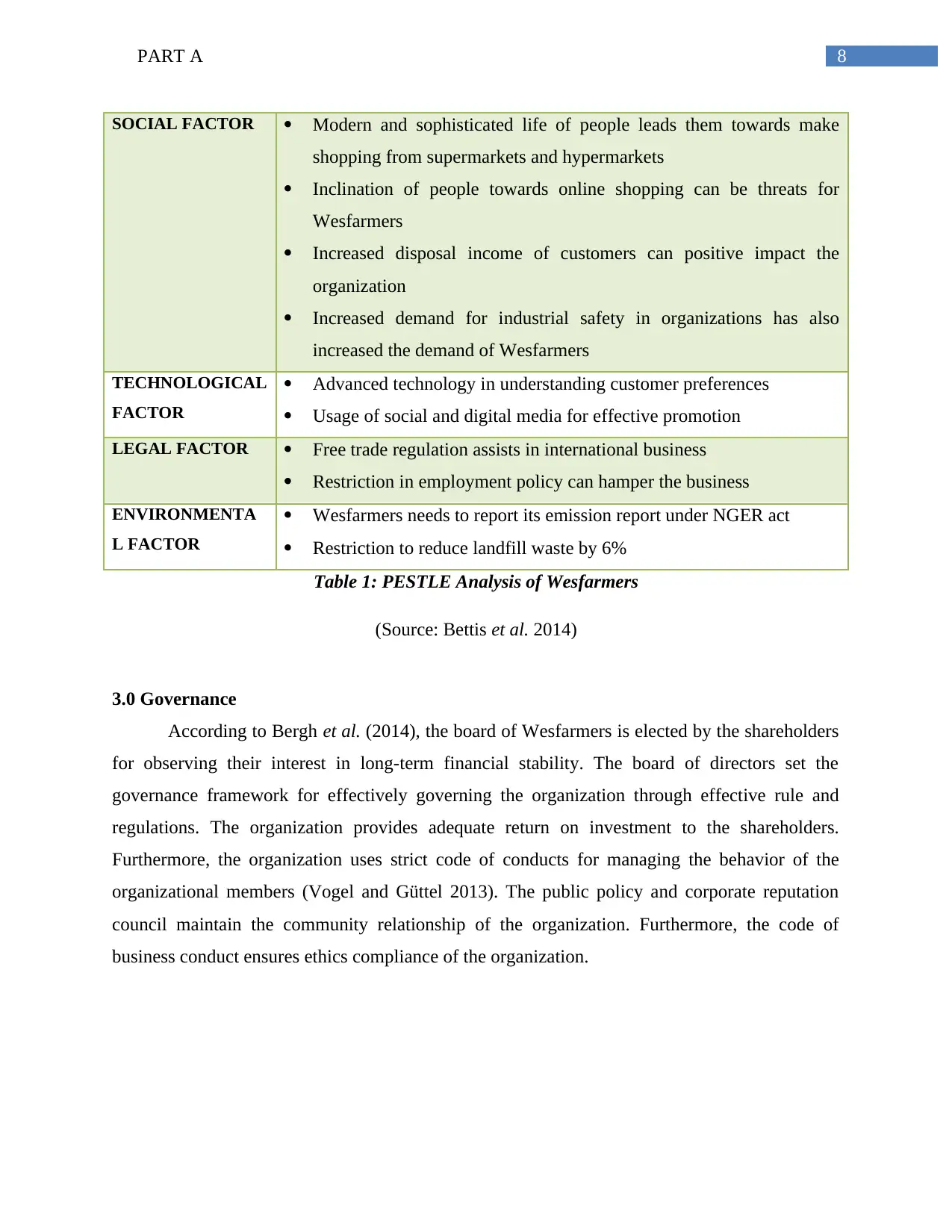
8PART A
SOCIAL FACTOR Modern and sophisticated life of people leads them towards make
shopping from supermarkets and hypermarkets
Inclination of people towards online shopping can be threats for
Wesfarmers
Increased disposal income of customers can positive impact the
organization
Increased demand for industrial safety in organizations has also
increased the demand of Wesfarmers
TECHNOLOGICAL
FACTOR
Advanced technology in understanding customer preferences
Usage of social and digital media for effective promotion
LEGAL FACTOR Free trade regulation assists in international business
Restriction in employment policy can hamper the business
ENVIRONMENTA
L FACTOR
Wesfarmers needs to report its emission report under NGER act
Restriction to reduce landfill waste by 6%
Table 1: PESTLE Analysis of Wesfarmers
(Source: Bettis et al. 2014)
3.0 Governance
According to Bergh et al. (2014), the board of Wesfarmers is elected by the shareholders
for observing their interest in long-term financial stability. The board of directors set the
governance framework for effectively governing the organization through effective rule and
regulations. The organization provides adequate return on investment to the shareholders.
Furthermore, the organization uses strict code of conducts for managing the behavior of the
organizational members (Vogel and Güttel 2013). The public policy and corporate reputation
council maintain the community relationship of the organization. Furthermore, the code of
business conduct ensures ethics compliance of the organization.
SOCIAL FACTOR Modern and sophisticated life of people leads them towards make
shopping from supermarkets and hypermarkets
Inclination of people towards online shopping can be threats for
Wesfarmers
Increased disposal income of customers can positive impact the
organization
Increased demand for industrial safety in organizations has also
increased the demand of Wesfarmers
TECHNOLOGICAL
FACTOR
Advanced technology in understanding customer preferences
Usage of social and digital media for effective promotion
LEGAL FACTOR Free trade regulation assists in international business
Restriction in employment policy can hamper the business
ENVIRONMENTA
L FACTOR
Wesfarmers needs to report its emission report under NGER act
Restriction to reduce landfill waste by 6%
Table 1: PESTLE Analysis of Wesfarmers
(Source: Bettis et al. 2014)
3.0 Governance
According to Bergh et al. (2014), the board of Wesfarmers is elected by the shareholders
for observing their interest in long-term financial stability. The board of directors set the
governance framework for effectively governing the organization through effective rule and
regulations. The organization provides adequate return on investment to the shareholders.
Furthermore, the organization uses strict code of conducts for managing the behavior of the
organizational members (Vogel and Güttel 2013). The public policy and corporate reputation
council maintain the community relationship of the organization. Furthermore, the code of
business conduct ensures ethics compliance of the organization.
⊘ This is a preview!⊘
Do you want full access?
Subscribe today to unlock all pages.

Trusted by 1+ million students worldwide
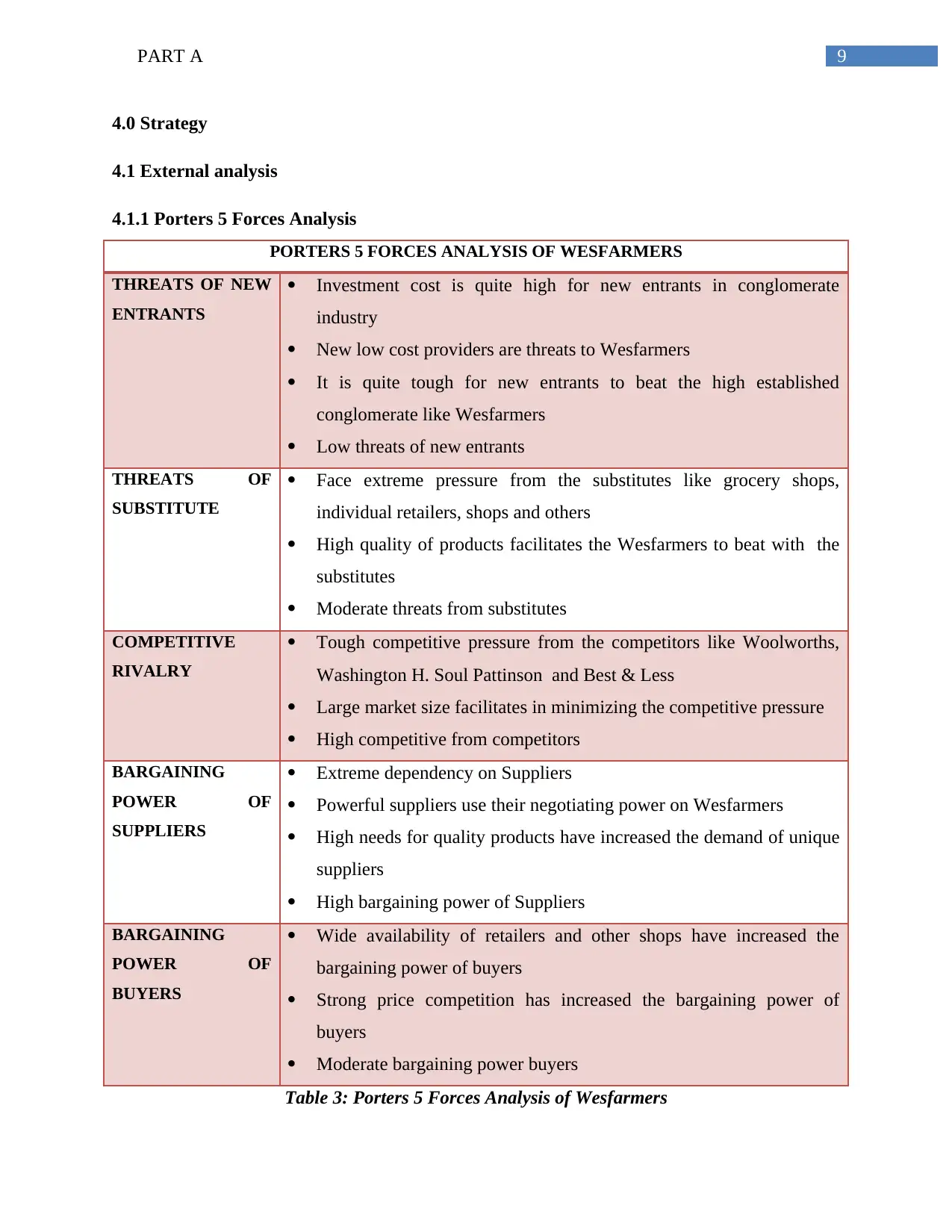
9PART A
4.0 Strategy
4.1 External analysis
4.1.1 Porters 5 Forces Analysis
PORTERS 5 FORCES ANALYSIS OF WESFARMERS
THREATS OF NEW
ENTRANTS
Investment cost is quite high for new entrants in conglomerate
industry
New low cost providers are threats to Wesfarmers
It is quite tough for new entrants to beat the high established
conglomerate like Wesfarmers
Low threats of new entrants
THREATS OF
SUBSTITUTE
Face extreme pressure from the substitutes like grocery shops,
individual retailers, shops and others
High quality of products facilitates the Wesfarmers to beat with the
substitutes
Moderate threats from substitutes
COMPETITIVE
RIVALRY
Tough competitive pressure from the competitors like Woolworths,
Washington H. Soul Pattinson and Best & Less
Large market size facilitates in minimizing the competitive pressure
High competitive from competitors
BARGAINING
POWER OF
SUPPLIERS
Extreme dependency on Suppliers
Powerful suppliers use their negotiating power on Wesfarmers
High needs for quality products have increased the demand of unique
suppliers
High bargaining power of Suppliers
BARGAINING
POWER OF
BUYERS
Wide availability of retailers and other shops have increased the
bargaining power of buyers
Strong price competition has increased the bargaining power of
buyers
Moderate bargaining power buyers
Table 3: Porters 5 Forces Analysis of Wesfarmers
4.0 Strategy
4.1 External analysis
4.1.1 Porters 5 Forces Analysis
PORTERS 5 FORCES ANALYSIS OF WESFARMERS
THREATS OF NEW
ENTRANTS
Investment cost is quite high for new entrants in conglomerate
industry
New low cost providers are threats to Wesfarmers
It is quite tough for new entrants to beat the high established
conglomerate like Wesfarmers
Low threats of new entrants
THREATS OF
SUBSTITUTE
Face extreme pressure from the substitutes like grocery shops,
individual retailers, shops and others
High quality of products facilitates the Wesfarmers to beat with the
substitutes
Moderate threats from substitutes
COMPETITIVE
RIVALRY
Tough competitive pressure from the competitors like Woolworths,
Washington H. Soul Pattinson and Best & Less
Large market size facilitates in minimizing the competitive pressure
High competitive from competitors
BARGAINING
POWER OF
SUPPLIERS
Extreme dependency on Suppliers
Powerful suppliers use their negotiating power on Wesfarmers
High needs for quality products have increased the demand of unique
suppliers
High bargaining power of Suppliers
BARGAINING
POWER OF
BUYERS
Wide availability of retailers and other shops have increased the
bargaining power of buyers
Strong price competition has increased the bargaining power of
buyers
Moderate bargaining power buyers
Table 3: Porters 5 Forces Analysis of Wesfarmers
Paraphrase This Document
Need a fresh take? Get an instant paraphrase of this document with our AI Paraphraser
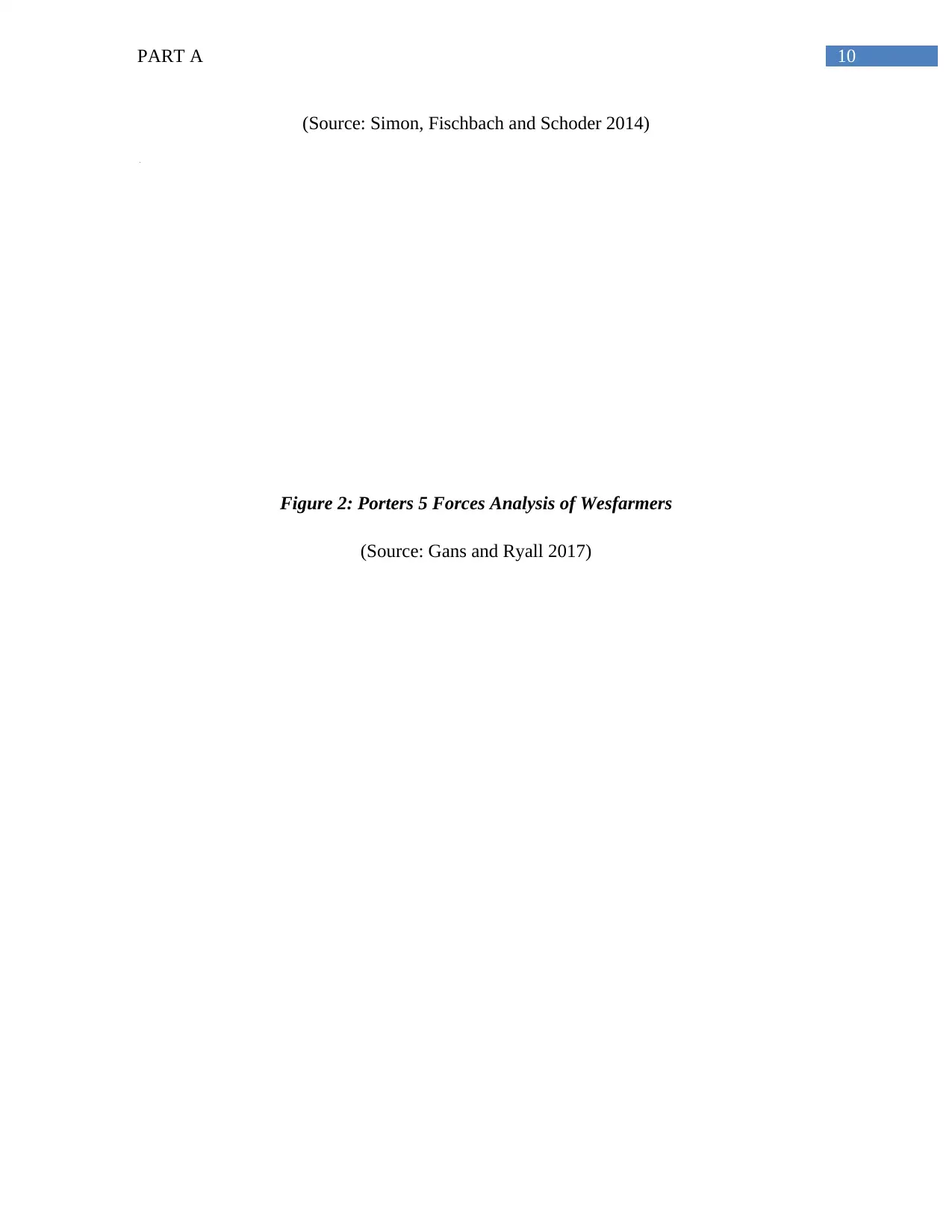
10PART A
(Source: Simon, Fischbach and Schoder 2014)
Figure 2: Porters 5 Forces Analysis of Wesfarmers
(Source: Gans and Ryall 2017)
(Source: Simon, Fischbach and Schoder 2014)
Figure 2: Porters 5 Forces Analysis of Wesfarmers
(Source: Gans and Ryall 2017)
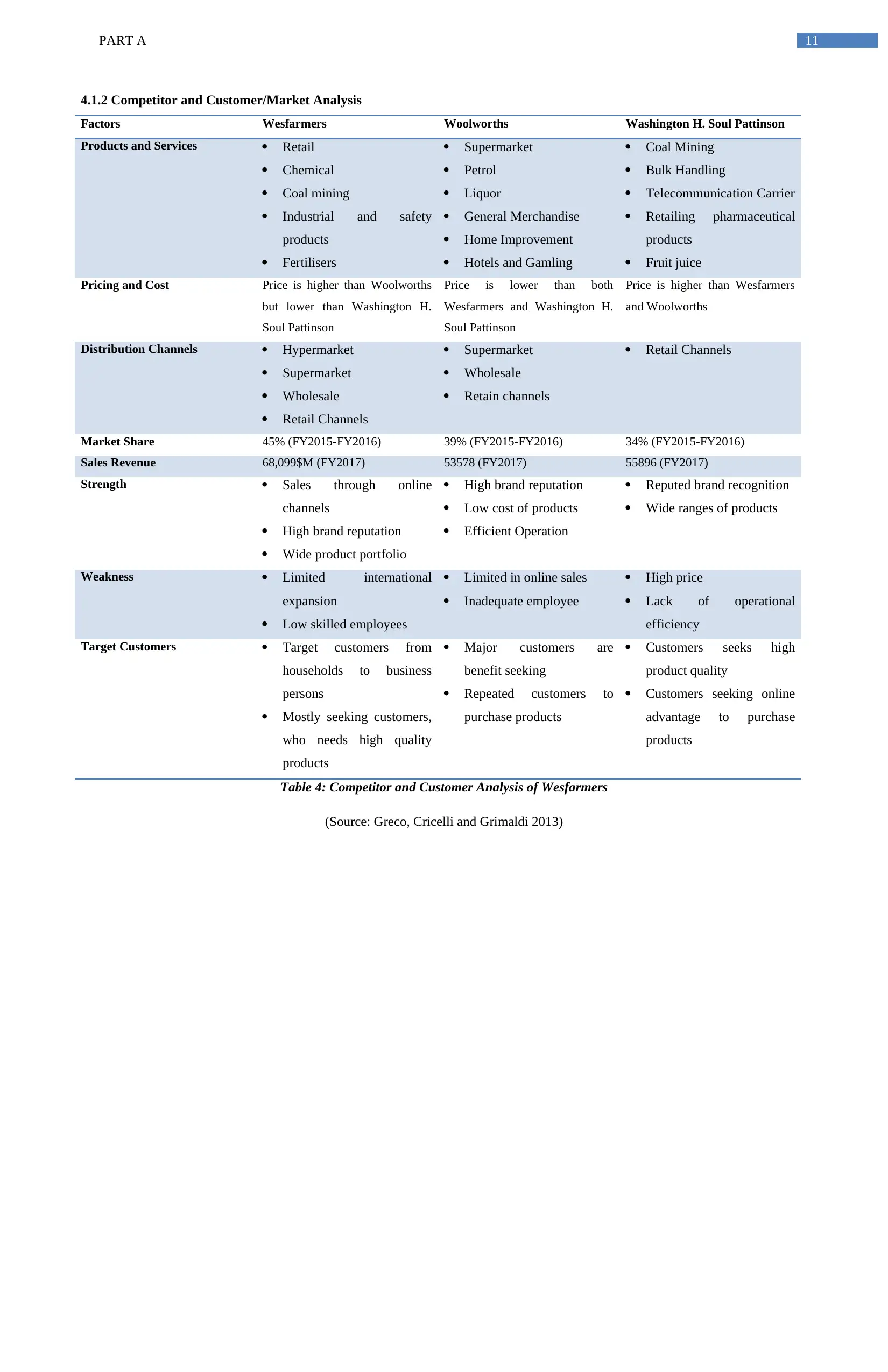
11PART A
4.1.2 Competitor and Customer/Market Analysis
Factors Wesfarmers Woolworths Washington H. Soul Pattinson
Products and Services Retail
Chemical
Coal mining
Industrial and safety
products
Fertilisers
Supermarket
Petrol
Liquor
General Merchandise
Home Improvement
Hotels and Gamling
Coal Mining
Bulk Handling
Telecommunication Carrier
Retailing pharmaceutical
products
Fruit juice
Pricing and Cost Price is higher than Woolworths
but lower than Washington H.
Soul Pattinson
Price is lower than both
Wesfarmers and Washington H.
Soul Pattinson
Price is higher than Wesfarmers
and Woolworths
Distribution Channels Hypermarket
Supermarket
Wholesale
Retail Channels
Supermarket
Wholesale
Retain channels
Retail Channels
Market Share 45% (FY2015-FY2016) 39% (FY2015-FY2016) 34% (FY2015-FY2016)
Sales Revenue 68,099$M (FY2017) 53578 (FY2017) 55896 (FY2017)
Strength Sales through online
channels
High brand reputation
Wide product portfolio
High brand reputation
Low cost of products
Efficient Operation
Reputed brand recognition
Wide ranges of products
Weakness Limited international
expansion
Low skilled employees
Limited in online sales
Inadequate employee
High price
Lack of operational
efficiency
Target Customers Target customers from
households to business
persons
Mostly seeking customers,
who needs high quality
products
Major customers are
benefit seeking
Repeated customers to
purchase products
Customers seeks high
product quality
Customers seeking online
advantage to purchase
products
Table 4: Competitor and Customer Analysis of Wesfarmers
(Source: Greco, Cricelli and Grimaldi 2013)
4.1.2 Competitor and Customer/Market Analysis
Factors Wesfarmers Woolworths Washington H. Soul Pattinson
Products and Services Retail
Chemical
Coal mining
Industrial and safety
products
Fertilisers
Supermarket
Petrol
Liquor
General Merchandise
Home Improvement
Hotels and Gamling
Coal Mining
Bulk Handling
Telecommunication Carrier
Retailing pharmaceutical
products
Fruit juice
Pricing and Cost Price is higher than Woolworths
but lower than Washington H.
Soul Pattinson
Price is lower than both
Wesfarmers and Washington H.
Soul Pattinson
Price is higher than Wesfarmers
and Woolworths
Distribution Channels Hypermarket
Supermarket
Wholesale
Retail Channels
Supermarket
Wholesale
Retain channels
Retail Channels
Market Share 45% (FY2015-FY2016) 39% (FY2015-FY2016) 34% (FY2015-FY2016)
Sales Revenue 68,099$M (FY2017) 53578 (FY2017) 55896 (FY2017)
Strength Sales through online
channels
High brand reputation
Wide product portfolio
High brand reputation
Low cost of products
Efficient Operation
Reputed brand recognition
Wide ranges of products
Weakness Limited international
expansion
Low skilled employees
Limited in online sales
Inadequate employee
High price
Lack of operational
efficiency
Target Customers Target customers from
households to business
persons
Mostly seeking customers,
who needs high quality
products
Major customers are
benefit seeking
Repeated customers to
purchase products
Customers seeks high
product quality
Customers seeking online
advantage to purchase
products
Table 4: Competitor and Customer Analysis of Wesfarmers
(Source: Greco, Cricelli and Grimaldi 2013)
⊘ This is a preview!⊘
Do you want full access?
Subscribe today to unlock all pages.

Trusted by 1+ million students worldwide
1 out of 20
Related Documents
Your All-in-One AI-Powered Toolkit for Academic Success.
+13062052269
info@desklib.com
Available 24*7 on WhatsApp / Email
![[object Object]](/_next/static/media/star-bottom.7253800d.svg)
Unlock your academic potential
Copyright © 2020–2025 A2Z Services. All Rights Reserved. Developed and managed by ZUCOL.




